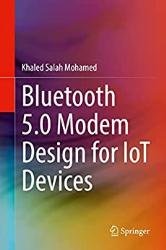Bluetooth 5.0 Modem Design for IoT Devices
- Добавил: literator
- Дата: 14-11-2021, 13:34
- Комментариев: 0
 Название: Bluetooth 5.0 Modem Design for IoT Devices
Название: Bluetooth 5.0 Modem Design for IoT DevicesАвтор: Khaled Salah Mohamed
Издательство: Springer
Год: 2022
Страниц: 120
Язык: английский
Формат: pdf (true), epub
Размер: 20.7 MB
This book provides an introduction to Bluetooth technology, with a specific focus on developing a hardware architecture for its modem. The major concepts and techniques involved in Bluetooth technology are discussed, with special emphasis on hardware mapping. The book starts simply to allow the reader to master quickly the basic concepts, before addressing the advanced features. This book differs from existing content in that it presents Bluetooth Transceiver architecture suitable for implementation in an FPGA for IoT Devices. It will examine several digital algorithms for modulation and demodulation of Bluetooth signals, locking on the carrier phase, and synchronizing the symbol. Many of these previously analog designs have been translated to the digital domain.
Among various beacon schemes, Bluetooth Low Energy (BLE) beacon is one of the most promising systems for enabling IoT. Bluetooth Low Energy (BLE) is widely used as a low-power communication protocol for short-range IoT sensors. As the BLE standard requires greatly relaxed specifications compared to the classic Bluetooth standard, the implementation of a low-power BLE transceiver with a simple structure is possible.
Bluetooth Low Energy (BLE) is considered as a short-range, energy-efficient, low-power, and low-cost radio technology for enabling IoT. Bluetooth is short-range wireless communication standard designed with an intention of replacing cables connecting portable and desktop devices and building wireless networks for such devices and enabling communication to be established between these devices up to maximum distance of 100 meters without obstacles. Bluetooth features robustness, low cost, low complexity, and low power; it uses the free industrial, scientific, and medical (ISM) frequency band (2.4–2.48 GHz).
The Bluetooth specification is an open specification that is governed by the Bluetooth Special Interest Group (SIG). The Bluetooth SIG is led by its five founding companies and four new member companies who were added in late 1999. This book provides an introduction to Bluetooth technology, with a specific focus on developing a hardware architecture for its modem. The major concepts and techniques involved in Bluetooth technology are discussed, with special emphasis on hardware mapping. The book starts simply to allow the reader to quickly master the basic concepts before addressing the advanced features.
This book differs from the researches published up to date in that it presents Bluetooth transceiver architecture suitable for implementation in an FPGA. It examines several digital algorithms for modulation and demodulation of Bluetooth signals, locking on the carrier phase, and synchronizing the symbol. Many of these previously analog designs have been translated to the digital domain.
The existing literature does not study modem architectures to determine an effective implementation to handle the variation in bit rate due to different constellations while minimizing redundant hardware required to operate on multiple constellations in an FPGA. Literature is also deficient on synchronization techniques for multiple constellations and the implementation of these techniques in an FPGA.
Presents Bluetooth Transceiver architecture suitable for implementation in an FPGA;
Includes comparative study between different architectures;
Discusses the tradeoff between cost and performance when a Bluetooth transceiver is designed using non-data aided techniques for clock and timing recovery.
Скачать Bluetooth 5.0 Modem Design for IoT Devices
Внимание
Уважаемый посетитель, Вы зашли на сайт как незарегистрированный пользователь.
Мы рекомендуем Вам зарегистрироваться либо войти на сайт под своим именем.
Уважаемый посетитель, Вы зашли на сайт как незарегистрированный пользователь.
Мы рекомендуем Вам зарегистрироваться либо войти на сайт под своим именем.
Информация
Посетители, находящиеся в группе Гости, не могут оставлять комментарии к данной публикации.
Посетители, находящиеся в группе Гости, не могут оставлять комментарии к данной публикации.
